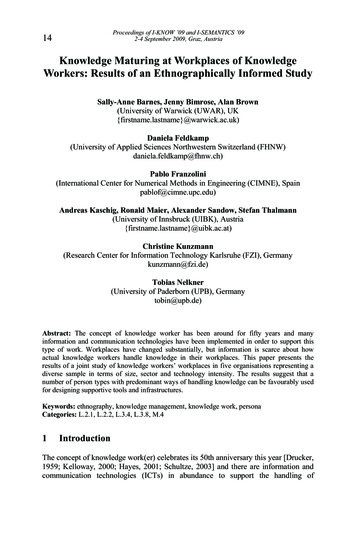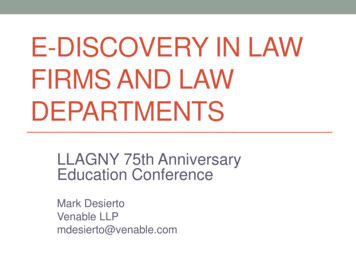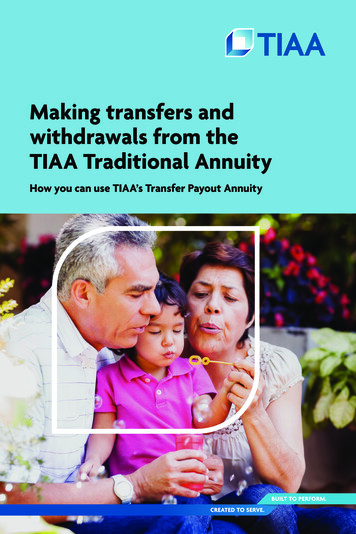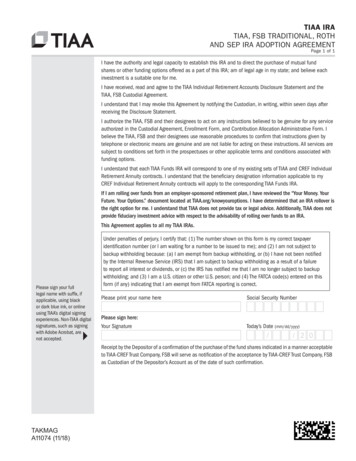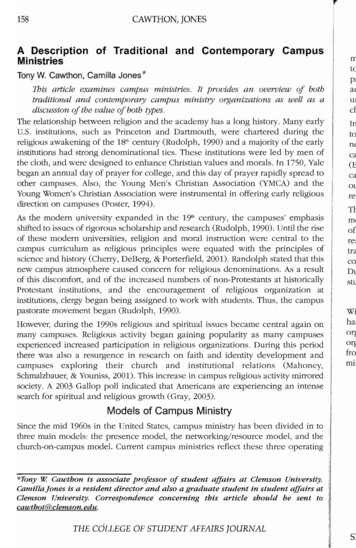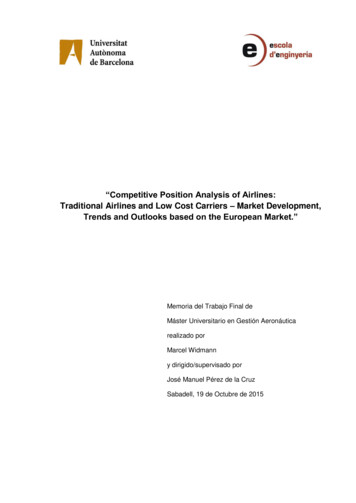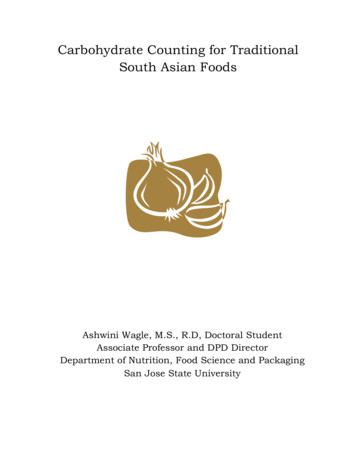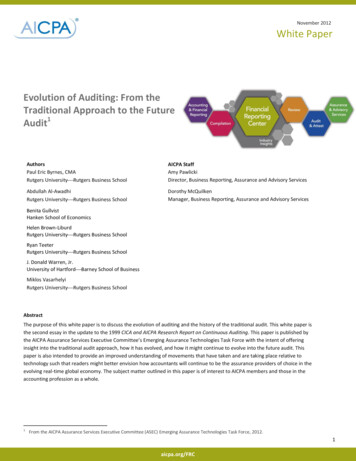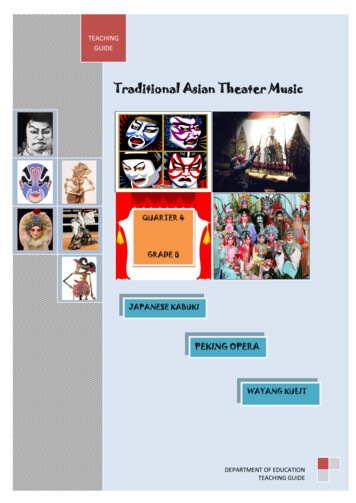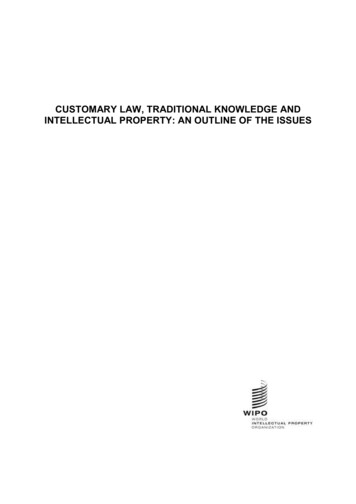
Transcription
CUSTOMARY LAW, TRADITIONAL KNOWLEDGE ANDINTELLECTUAL PROPERTY: AN OUTLINE OF THE ISSUES
World Intellectual Property Organization, 2013. Certain rights reserved. WIPO authorizes thepartial reproduction, translation and dissemination of this publication for non-commercial and nonprofit scientific, educational or research purposes, provided that WIPO and the publication areproperly identified and acknowledged. Permission to substantially reproduce, disseminate and/ortranslate this publication, or compile or create derivative works therefrom, in any form, whether forcommercial/for profit or nonprofit purposes, must be requested in writing. For this purpose, WIPOmay be contacted at www.wipo.int under “Contact us”.Disclaimer: This publication does not necessarily represent the views of WIPO or any of its MemberStates. This publication is not a substitute for legal advice. Its purpose is limited to providing basicinformation.1
Table of ContentsCUSTOMARY LAW AND INTELLECTUAL PROPERTY SYSTEM: THE ISSUES.2WHAT IS CUSTOMARY LAW?.2ROLE OF CUSTOMARY LAW IN PROTECTING TRADITIONAL KNOWLEDGE AND TRADITIONALCULTURAL EXPRESSIONS.4CUSTOMARY LAW AND INTELLECTUAL PROPERTY: A BRIEF OVERVIEW .4ASPECTS OF THE INTELLECTUAL PROPERTY SYSTEM .7WIPO WORK ON TK AND TCES: BACKGROUND TO THIS ISSUES PAPER .8UNDERSTANDING CUSTOMARY LAW AND STRENGTHENING ITS COMMUNITY ROLE .9THE SOCIAL CONTEXT OF CUSTOMARY LAW. 10OVERVIEW OF THE ISSUES . 11WHAT IS CUSTOMARY LAW? WHEN IS IT LAW; FOR WHOM IS IT LAW?. 11CUSTOMARY LAW AND THE CHARACTER OF TRADITIONAL KNOWLEDGE . 12THE PRINCIPLE OF LOCALITY . 13APPROACHES TO RECOGNIZING CUSTOMARY LAWS AND PROTOCOLS . 15PATHWAYS FOR RECOGNITION OF CUSTOMARY LAW . 17THE SCOPE OF RECOGNITION OF CUSTOMARY LAW AND PRACTICES . 18RECOGNIZING CUSTOMARY LAWS AND PROTOCOLS BEYOND IP LAW . 18CUSTOMARY LAW UNDER EXISTING SUI GENERIS SYSTEMS . 22CUSTOMARY LAW AND PROTOCOLS IN ADR PROCEDURES . 23CUSTOMARY LAW AND THE EXERCISE OF COLLECTIVE RIGHTS OVER TK AND TCES . 24CONCLUSION . 27FORMS OF RECOGNITION . 27ENHANCING THE EFFECT OF CUSTOMARY LAW . 27FUNDAMENTAL ISSUES FOR CONSIDERATION . 28SOME RESOURCES . 291
Customary law and intellectual property system: the issuesWhat is customary law?Defining and characterising “customary law” would itself be the subject of an extended study.The present study does not attempt to define “customary law”, but some general commentson its character may be helpful.First, the idea of “customary law” that is under consideration concerns the laws, practicesand customs of indigenous peoples and local communities. It is not, for instance, the sameidea as “customary law” in the international context. “Customary international law” has amore precise and technical meaning in the realm of rules governing relations betweendistinct States, referring to those aspects of international law that are based on custom orpractice between States. The Charter of the United Nations annexes the Statute of thePermanent Court of International Justice, which requires it, when deciding disputes inaccordance with international law, to apply (among other things) “international custom, asevidence of a general practice accepted.” Some experts have suggested that there are orshould be linkages or overlap between customary international law and the customary law ofindigenous peoples and local communities, but in general these two distinct areas of law andpractice should not be confused with one another.Customary law is, by definition, intrinsic to the life and custom of indigenous peoples andlocal communities. What has the status of “custom” and what amounts to “customary law”as such will depend very much on how indigenous peoples and local communitiesthemselves perceive these questions, and on how they function as indigenous peoples andlocal communities. According to one definition, “custom” is a “rule of conduct, obligatory onthose within its scope, established by long usage. Are valid custom must be of immemorialantiquity, certain and reasonable, obligatory, not repugnant to Statute Law, though it mayderogate from the common law. General customs are those of the whole country, as, e.g.the general custom of merchants. Particular customs are the usage of particular traits. Localcustoms are customs of certain parts of the country.”1Approaches to defining or characterising “customary law” typically make some reference toan established pattern within a community which is seen by the community itself as having abinding quality. For instance, customary laws are defined variously by some authorities as “customs that are accepted as legal requirements or obligatory rules of conduct;practices and beliefs that are so vital and intrinsic a part of a social and economicsystem that they are treated as if they were laws”2, and “established patterns of behaviour that can be objectively verified within a particularsocial setting. The modern codification of civil law developed out of the customs, orcoutumes of the middle ages, expressions of law that developed in particularcommunities and slowly collected and written down by local jurists. Such customsacquired the force of law when they became the undisputed rule by which certainentitlements (rights) or obligations were regulated between members of acommunity.”3Another term used is “consuetudinary law” (from the Latin, consuetudo: custom), referring tolaw the validity of which is established by custom (in contrast to specific legislation orstatutory law). A recent workshop defined customary law as “locally recognized principles,123Osborne’s Concise Law Dictionary, Ninth Edition (Sweet and Maxwell, 2001)Black’s Law Dictionary, 8th edition, 2004http://en.wikipedia.org/wiki/Customary law2
and more specific norms or rules, which are orally held and transmitted, and applied bycommunity institutions to internally govern or guide all aspects of life.” 4This section of the study explores the interaction between the customary law and protocolsof indigenous peoples and local communities, and intellectual property (IP) systems. Theissues to be considered include: What is the nature of the customary law and protocols of indigenous peoples andlocal communities, and other communities bound by such laws? Can commonthemes or elements be identified, or are customary laws and protocols simply toodiverse? What relationships between customary law and IP law have been encountered inpractice? What models could be explored? How has customary law been recognized or applied in other areas of law, such asfamily law, the law of succession, the law of land tenure and natural resources,constitutional law, human rights law and criminal law, as well as the law and practiceof dispute resolution in general? How does customary law define the very legal orcultural identity of indigenous peoples and local communities? What lessons doesthis wider experience offer to the law and practice of IP? What experiences have been reported concerning the role of customary law inrelation to intangible property, and rights and obligations relating to intangibleproperty such as cultural expressions, traditional knowledge5 (TK), and specificmaterial such as motifs, designs, narratives, as well as the tangible form ofexpressions such as handicrafts, tools, and forms of dress? How do sui generis laws for the protection of TK and traditional cultural expressions6(TCEs)/expressions of folklore (EoF) apply or otherwise recognize customary law? For the holders of TK/TCEs/genetic resources7 (GRs) themselves, what is thepreferred role or roles of customary laws and protocols: As a basis for sustainable community-based development, strengthenedindigenous peoples and local communities’ identity, and promotion of culturaldiversity? As a distinct source of law, legally binding in itself – on members of the originalcommunity, and on individuals outside the community circle, including in foreignjurisdictions?4For example, Protecting Community Rights over Traditional Knowledge:Implications of Customary Laws and Practices, Research Planning Workshop, Cusco, Peru, 20-25 May 2005,5“Traditional knowledge”, as a broad description of subject matter, generally includes the intellectual andintangible cultural heritage, practices and knowledge systems of traditional communities, including indigenousand local communities (TK in a general sense or lato sensu). In other words, TK in a general sense embraces thecontent of knowledge itself as well as TCEs, including distinctive signs and symbols associated with TK. In thepresent document, “TK” in the narrow sense refers to knowledge as such, in particular the knowledge resultingfrom intellectual activity in a traditional context, and includes know-how, practices, skills, and innovations. TK canbe found in a wide variety of contexts, including: agricultural knowledge; scientific knowledge; technicalknowledge; ecological knowledge; medicinal knowledge, including related medicines and remedies; andbiodiversity-related knowledge, etc.6“Traditional cultural expressions” refer to tangible and intangible forms in which TK and cultures areexpressed, communicated or manifested. Examples include traditional music, performances, narratives, namesand symbols, designs and architectural forms. The terms “TCEs” and “expressions of folklore” (EoF) are used asinterchangeable synonyms.7Article 2 of the Convention on Biological Diversity (1992) defines “genetic resources” as “geneticmaterial of actual or potential value”.3
As a means of factually guiding the interpretation of laws and principles that applybeyond the traditional reach of customary law and protocols?As a component of culturally appropriate forms of alternative dispute resolution?As a condition of access to TK and TCEs?As the basis for continuing use rights, recognized as exceptions or limitations toany other rights granted over TK/TCEs or related and derivative subject matter?Role of customary law in protecting traditional knowledge and traditional culturalexpressionsThe WIPO Intergovernmental Committee on Intellectual Property and Genetic Resources,Traditional Knowledge and Folklore (IGC) was established by the WIPO General Assemblyin October 2000. Negotiations are currently underway in the IGC towards the developmentof an international legal instrument for the effective protection of TK and TCEs, and toaddress the IP aspects of access to and benefit-sharing of GRs.The WIPO draft articles on the protection of TK and TCEs and a number of national suigeneris laws and the conventional IP law set out several possible roles for customary lawwhich have already been developed or applied in practice. Customary law can serve as: The fundamental legal basis or source of law for indigenous peoples and localcommunities’ legal rights over TK or TCEs.A factual element in establishing indigenous peoples and local communities’collective rights over TK or TCEs.One element of the definition of TK or TCEs, or can otherwise establish therelationship to indigenous peoples and local communities that is central to theconcept of TK and TCEs.A means of determining or guiding the procedures to be followed in securingindigenous peoples and local communities’ free prior informed consent.The basis of specific user rights or exceptions, exempting the continuing customaryuses and practices from other legal restrictions on the use of TK or TCEs.Guide for the assessment of cultural or spiritual offence or damage caused byinappropriate forms of use of TK or TCEs.A determinant of or guide for how benefits from the use of TK or TCEs should beequitably shared within a community.A means of determining appropriate forms of remedies, sanctions or restitutionfollowing the breach of rights over TK or TCEs.An avenue for resolving disputes over ownership or other forms of custodianshipover TK or TCEs.A guide on the transmission of rights over TK or TCEs from one generation to afollowing generation.Customary law and intellectual property: a brief overviewCustomary laws and protocols are central to the very identity of many indigenous peoplesand local communities. These laws and protocols concern many aspects of their life. Theycan define rights and responsibilities of members of indigenous peoples and localcommunities on important aspects of their life, culture and world view: customary law canrelate to use of and access to natural resources, rights and obligations relating to land,inheritance and property, conduct of spiritual life, maintenance of cultural heritage andknowledge systems, and many other matters. Customary law can help define orcharacterize the very identity of the community itself. Further, for many indigenous peoplesand local communities, it may be meaningless or inappropriate to differentiate their laws as4
“customary”, suggesting it has some lesser status than other law – it simply constitutes theirlaw as such.Maintaining customary laws and protocols can therefore be crucial for the continuing vitalityof the intellectual, cultural and spiritual life and heritage of indigenous peoples and localcommunities. Customary laws and protocols can define how traditional cultural heritage isshared and developed, and how TK systems are appropriately sustained and managed byindigenous peoples and local communities.So maintaining customary laws and protocols even within the original community is animportant concern; it is often a key aspect of preserving the cultural and legal identity ofindigenous peoples and local communities. But indigenous peoples and local communitieshave also called for various forms of respect and recognition of their customary laws andprotocols – beyond the scope of indigenous peoples and local communities themselves.This can be a complex issue in national constitutional law, and may arise, for example, inclaims over land and natural resources.The call for wider respect and recognition of customary laws and protocols has also been aconsistent feature of international policy discussions on protection of TCEs, TK and relatedGRs. For example, when WIPO consulted with the holders of TCEs and TK on their needsand expectations relating to IP system, one common theme was the need for recognition ofcustomary law8. Why? The experiences and perspectives of indigenous peoples and localcommunities are of course as diverse as themselves. But many indigenous peoples andlocal communities express concern that the bare content of their distinctive cultural heritageand knowledge systems should not be considered in isolation from the customary andcommunity context. From this perspective, the form or representation of a culturalexpression and the content of knowledge should not be appropriated without recognition ofthe legal and cultural context that helps define them as distinctively “traditional”.So indigenous peoples and local communities have called for wider respect and recognitionof their customary law and practices as one aspect of the appropriate protection of their TKand TCEs. Of all the aspects of indigenous peoples and local communities’ collectivecultural and intellectual heritage, their TK and TCEs are most easily appropriated by thirdparties – exactly because they are intangible and more readily copied. A sacred site that isof importance to indigenous peoples and local communities cannot be violated by a thirdparty; but a sacred symbol, or sacred knowledge, can be appropriated and used in a remotelocation, far from indigenous peoples and local communities; a sacred cultural expressioncan be replicated in large quantities for commercial purposes. One well-known case in thefield of the law of TCEs concerns a sacred motif, protected under indigenous customary lawwhich was copied onto carpets produced in a foreign country.9What role should customary law, protocols and practices play in the wider protection ofTCEs and TK? This is a challenging question; it raises a host of policy and legal issues.But key stakeholders – above all, the holders and custodians of TK and TCEs themselves –have stressed that respect and recognition of customary law is integral to appropriateprotection of TCEs, TK and related GRs against misuse and misappropriation by others.The customary context may indeed help clarify or define what these terms actually mean:what makes cultural expressions and knowledge “traditional” may be the very fact that theyare developed, maintained and disseminated in a customary and intergenerational context;89See WIPO Report on Fact-finding Missions on Intellectual Property and Traditional Knowledge (19981999) “Intellectual Property Needs and Expectations of Traditional Knowledge Holders” (WIPOpublication no. 768(E)).See Terri Janke, Minding Culture: Case Studies on Intellectual Property and Traditional CulturalExpressions, available at /cultural/mindingculture/studies/finalstudy.pdf5
and often that context will be defined and shaped by customary law, protocols and practices.So even the basic question in discussing protection of TK and TCEs – what do those termsrefer to – may entail a better understanding of the nature of customary law.As noted, customary laws and protocols are an intrinsic part of the life, values, world viewand the very identity of many indigenous peoples and local communities. By one definition,customary law is “law consisting of customs that are accepted as legal requirements orobligatory rules of conduct; practices and beliefs that are so vital and intrinsic a part of asocial and economic system that they are treated as if they were laws”.10A major debate arises over that “as if”: what makes a customary practice a “law” and gives itbinding effect, and when is it “just” practice? And if it is obligatory, who is bound by it, withinand beyond the relevant indigenous peoples and local communities? A customary practicemay effectively govern or guide many aspects of indigenous peoples and local communities’life, but it may be so engrained within indigenous peoples and local communities andembedded in the way it lives and works, that it may not be perceived as stand-alone,codified “laws” as such. The binding effect of a customary practice may only be fullyperceived when the practice is contravened. This could occur, for example, when TK isused by third parties in a way that conflicts with the customary laws that determine how it isused and transmitted by indigenous peoples and local communities: this can lead to calls forthe customary laws to be respected by such third parties, as either a legal or an ethicalobligation.This paper seeks to cover the full range of customary laws, protocols and practices, withoutseeking to prejudge whether they are actually binding as laws, or should be binding as laws,or are simply a reflection of the way certain people happen to live. Various rules andpractices are likely to fall within a wide spectrum between formal legal obligations and simplecommunity practices: this discussion is intended to cover this full spectrum, without passingjudgement on any particular perspective on this complex legal question.Example of customary lawThe customary law of the Quechua peoples of the Andean region provides one example of acustomary law system. Key principles of Quechua law include the following: Reciprocity: encompasses the principle of equity, and provides the basis fornegotiation and exchange between humans, and with the Pachamama (Mother Earth); Duality: indicates that everything has an opposite which complements it; behaviourcannot be individualistic, for example, in the union between man and woman; and that othersystems or paradigms can be accepted; Equilibrium: refers to balance and harmony, in both nature and society – e.g. respectfor the ‘Pachamama’ and mountain gods; resolving conflicts to restore social harmony; andcomplementarities (e.g. between ecological niches). Equilibrium needs to be observed inapplying customary laws, all of which are essentially derived from this principle.Source: Alejandro Argumedo, “The Potato Park as a Sui Generis System for the Protectionof Traditional Knowledge”10Black’s Law Dictionary, 8th edition, 20046
Aspects of the intellectual property systemNo attempt is made in this study to define IP or to describe its legal characteristics in anydetail. IP laws ultimately operate through national laws and legal systems, and can differconsiderably between different countries. But some brief observations on some salientpoints of IP law may be useful: IP is a set of legal mechanisms that typically “protect” subject matter by determiningthe conditions under whether third parties can use a protected material, if at all. Inother words, the law gives the right holder a say over whether, and if so how, thismaterial is used by others. IP rights do not normally give their owners themselves apositive right to use the protected material (for example, copyright might exist in anobscene or grossly offensive book, but this does not give the author a positive right todistribute the book to the public). The IP right therefore gives its owner a right to determine and authorize whether andhow the protected material is commercialized, if at all. It may be used tocommercialize and disseminate one’s own material in the way one chooses, and as ameans of preventing others from commercializing one’s knowledge or expressions. IP may be a true property right – a tradable right to exclude third parties altogether –or a more limited right, such as an entitlement to take action against third parties or toclaim an equitable level of remuneration. IP systems overlap with the more generallaw of unfair competition. IP systems can also provide for a right of integrity (the rightto object to misuse or offensive distortion of one’s work) and a right of attribution (theright to be identified as author of a work). Generally, IP rights run for a certain term,after which the protected material goes into the public domain; but some forms of IP(e.g. trademarks and trade secrets) run for an indefinite period, provided theprotected material remains eligible. IP systems can acknowledge or recognize common forms of ownership or othercollective entitlements, such as when unfair competition, geographical indicationsand trademark laws acknowledge the interests of an agricultural community. Othercases have concerned indigenous peoples and local communities’ collective interestsin protecting sacred materials under copyright laws and the laws of confidentiality.Issues for consideration: in generalThe interplay between customary law and protocols and IP systems is complex. This paperidentifies some of the issues that may be important for future consideration; these are setout after each section. But there are some underlying and general themes that lie behindthese more detailed issues. Discussion and exploration of these broader themes may alsobe helpful. These issues include: How do customary law and practices define, shape and sustain TK and TCEs withinindigenous peoples and local communities? How can this role be better understoodby external parties? Where indigenous peoples and local communities themselveswish to strengthen the role of customary law in the governance of their TK and TCEs,what resources or other forms of support would they find helpful? What are the existing ways of recognizing or respecting customary law and practicesin the external environment, beyond indigenous peoples and local communities?What possible pathways could be developed? To what extent is this a matter of laws7
– national and sub-national laws, public international laws, private international laws?To what extent is it a matter of greater awareness, ethical guidelines, or capacitybuilding? How can customary law and practices be recognized specifically within IP system?What legal or operational contexts are relevant? What are the lessons of practicalexperience? What aspects or elements of customary law and practices can be understood andapplied beyond the social and cultural context of indigenous peoples and localcommunities who develop and follow them? What aspects or elements can only beunderstood by indigenous peoples and local communities?WIPO work on TK and TCEs: background to this issues paperIn 1998 and 1999, WIPO conducted fact-finding missions to 28 countries to identifyintellectual property needs and expectations of TK/TCEs holders. Many underscored theimportance of customary law and practices, and the need for their own laws and practices tobe better understood and respected. The lessons learned were gathered in a report.11 Thisreport included a recommendation for the preparation of a “study of customary laws andprotocols in local and traditional communities, including conclusions relevant for the formalIP system”. Preliminary work was undertaken on these issues in the context of approvedWIPO programs of work.12WIPO’s work in the general field of TK and TCEs had taken on a new dimension in 2000,when the Member States of WIPO agreed to establish the IGC. The IGC convened for thefirst time in 2001, taking up many questions concerning IP and the protection of TK andTCEs. The IGC is undertaking text-based negotiations with the objective of reachingagreement on a text of an international legal instrument (or instruments) which will ensurethe effective protection of TK, TCEs and GRs.13 Debate in the IGC has highlighted the needfor respect and recognition of customary laws, practices and protocols concerning theprotection of TK and TCEs.Customary law has been repeatedly cited as one potential element of an holistic approach toprotecting TK. The Conference of Parties of the CBD has indicated that protection of TKshould be “based on a combination of appropriate approaches . Including the use ofexiting intellectual property mechanisms, sui generis systems, customary law, the use ofcontractual arrangements, registers of traditional knowledge, and guidelines and codes ofpractice”.14 Similarly, IGC documents have noted the “irreducibly holistic quality” of TK, andhave explored a comprehensive approach that includes “existing IP systems (including anarray of IP rights and the law of unfair competition), adapted IP systems with sui generiselements, and new, stand-alone sui generis systems, as well as non-IP options, such astrade practices and labeling laws, liability rules, use of contracts, customary and indigenous11121314See WIPO Report on Fact-finding Missions on Intellectual Property and Traditional Knowledge (19981999) “Intellectual Property Needs and Expectations of Traditional Knowledge Holders” (WIPOpublication no. 768(E)).The approved WIPO Program and Budget for 2000-2001 included the development of “a study oncustomary law and regulatory systems that apply to the protection of knowledge, innovations andcreativity in local and traditional communities, including conclusions relevant for the formal intellectualproperty system” (Main Program 11).See the website of the IGC, http://www.wipo.int/tk/en/igc/.CBD COP Decision VI/10A, para 33.8
laws and protocols, regulation of access to genetic resources, and remedies based on suchtorts as unjust enrichment, rights of publicity, and blasphemy”.15This paper is made available to facilitate discussion and exploration of the issues, and toprovide some background information; it is not intended to be authoritative, comprehensive,or final in form, and critical review and suggestions for clearer, more accurate or morecomplete revisions of the paper are warmly invited.This paper therefore seeks to identify key issues for consideration, and to contribute todiscussion about customary laws and protocols as they may apply to the protection of TKand TCEs. It also deals more generally with the interaction between customary laws andprotocols and IP laws. There is a much broader debate about the recognition of customarylaws, which can arise in the context of self-governance, the rights of indigenous peoples andlocal communities, the preservation of cultural identity and intellectual and spiritual heritage,and self-determination.This paper aims to learn from and responds to this wider agenda and to learn fromdiscussion of the broader issues, but it does not attempt to survey the full debate nor tocapture its essence. Instead, this paper has a more specific focus, in view of its background,and it is not intended as a contribution to the wider debate about customary laws. Itaccordingly concentrates on the sp
law the validity of which is established by custom (in contrast to specific legislation or statutory law). A recent workshop defined customary law as “locally recognized principles, 1 Osborne’s Concise Law
